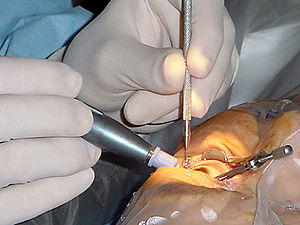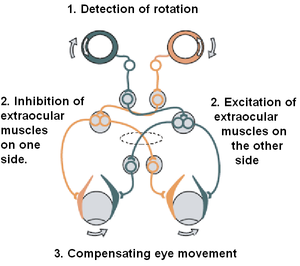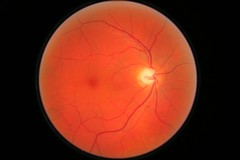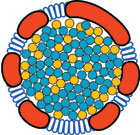
Statin use is not associated with risk of developing advanced, age-related macular degeneration (AMD), according to a study published in the Dec. issue of Ophthalmology.
In a study of 744 patients, researchers from the University of Pennsylvania found that among patients who had bilateral large drusen, use of the cholesterol-lowering medications was not associated with a higher or lower risk of progressing to advanced disease.
At baseline, all patients were at risk for advanced AMD but had not yet progressed to that stage.
At the end of the study, 39.8% of the participants reported using statins; about two-thirds starting taking the drugs during the trial.
The investigators theorized, however, that a protective effect may have been obscured because patients who are taking statins for cardiovascular disease are also at high risk for developing AMD.
 5:02 PM
5:02 PM
 Keshav Bhat
Keshav Bhat

![Reblog this post [with Zemanta]](http://img.zemanta.com/reblog_e.png?x-id=4aa14112-bbc5-4941-b05e-8460b2e9a131)

![Reblog this post [with Zemanta]](http://img.zemanta.com/reblog_e.png?x-id=0945228d-ea0a-4b03-94a1-2aacd7c05d87)
![Reblog this post [with Zemanta]](http://img.zemanta.com/reblog_e.png?x-id=2425f38c-effb-426d-83fb-00d6f53a6379)

![Reblog this post [with Zemanta]](http://img.zemanta.com/reblog_e.png?x-id=a96d1652-8ab5-4f72-a859-7a30d9bf7102)

![Reblog this post [with Zemanta]](http://img.zemanta.com/reblog_e.png?x-id=21bbca77-14d8-49b5-846d-1b78a64af719)

![Reblog this post [with Zemanta]](http://img.zemanta.com/reblog_e.png?x-id=533358b0-1b21-4d25-bb52-4fc557590aad)

![Reblog this post [with Zemanta]](http://img.zemanta.com/reblog_e.png?x-id=cb673e4f-0865-4943-b553-8492f4d512b7)
![Reblog this post [with Zemanta]](http://img.zemanta.com/reblog_e.png?x-id=830738dc-8a8e-4748-bb9f-30791e47293b)
![Reblog this post [with Zemanta]](http://img.zemanta.com/reblog_e.png?x-id=b577fde8-225b-4a33-b48d-0c81dc92207c)
![Reblog this post [with Zemanta]](http://img.zemanta.com/reblog_e.png?x-id=d0d0dcc1-bd82-4f99-8882-8f6eff897131)
![Reblog this post [with Zemanta]](http://img.zemanta.com/reblog_e.png?x-id=7c13c1e1-5545-4956-b6e1-ae82f266a104)
![Reblog this post [with Zemanta]](http://img.zemanta.com/reblog_e.png?x-id=017c5678-ae5c-4b82-b232-57fd20353006)


![Reblog this post [with Zemanta]](http://img.zemanta.com/reblog_e.png?x-id=03e72e0f-5125-4c17-9483-bcbbfdb5015d)
![Reblog this post [with Zemanta]](http://img.zemanta.com/reblog_e.png?x-id=5c69eaa1-f476-482e-9fcd-537a10d4b5c4)

![Reblog this post [with Zemanta]](http://img.zemanta.com/reblog_e.png?x-id=49333503-179f-4584-bfa4-708acf7792c5)

![Reblog this post [with Zemanta]](http://img.zemanta.com/reblog_e.png?x-id=384901cd-b733-4ebd-a37d-3353932b7038)

![Reblog this post [with Zemanta]](http://img.zemanta.com/reblog_e.png?x-id=11bdc177-520e-42c6-977b-94c324bb21dd)

![Reblog this post [with Zemanta]](http://img.zemanta.com/reblog_e.png?x-id=ed66092f-302d-4eca-8b66-547f9c4117b7)

![Reblog this post [with Zemanta]](http://img.zemanta.com/reblog_e.png?x-id=0d141bb9-3717-453e-83bc-5204210f0f4a)
![Reblog this post [with Zemanta]](http://img.zemanta.com/reblog_e.png?x-id=4ab6744d-6d4c-424e-9bae-2b608a2614a2)
![Reblog this post [with Zemanta]](http://img.zemanta.com/reblog_e.png?x-id=e6c9c4b8-1172-4309-9d85-e5a12094ed7d)

![Reblog this post [with Zemanta]](http://img.zemanta.com/reblog_e.png?x-id=1d167533-c482-4d68-8d2a-728e9704089a)


![Reblog this post [with Zemanta]](http://img.zemanta.com/reblog_e.png?x-id=8eb30069-4167-4b20-96e9-f880ad34d366)

![Reblog this post [with Zemanta]](http://img.zemanta.com/reblog_e.png?x-id=57a15bc5-1fba-4aaf-b412-3f5bbbe86abb)
![Reblog this post [with Zemanta]](http://img.zemanta.com/reblog_e.png?x-id=ab5b0f9a-3879-4317-9b32-8d73284308ff)

![Reblog this post [with Zemanta]](http://img.zemanta.com/reblog_e.png?x-id=079d7b05-db1f-4f9e-be96-a1fa89363f08)


